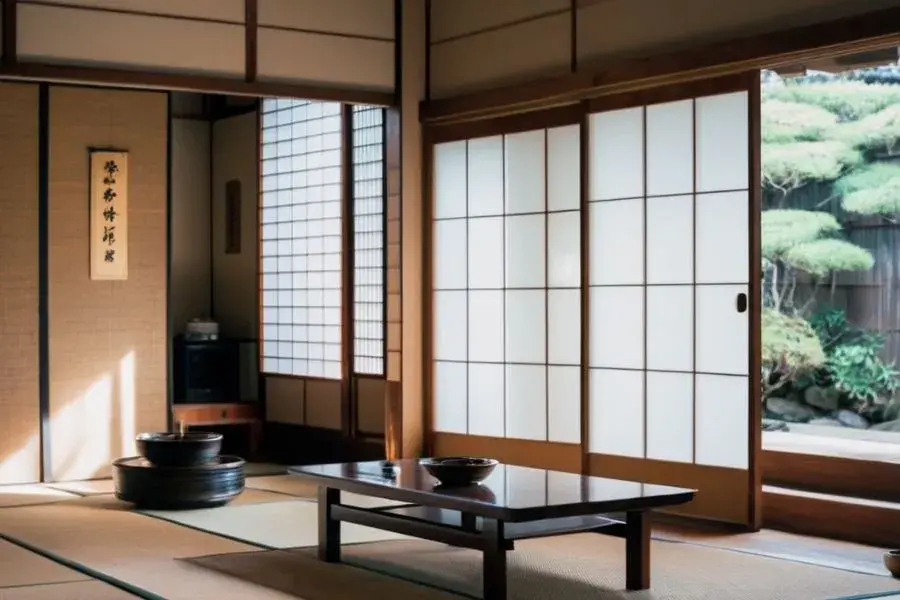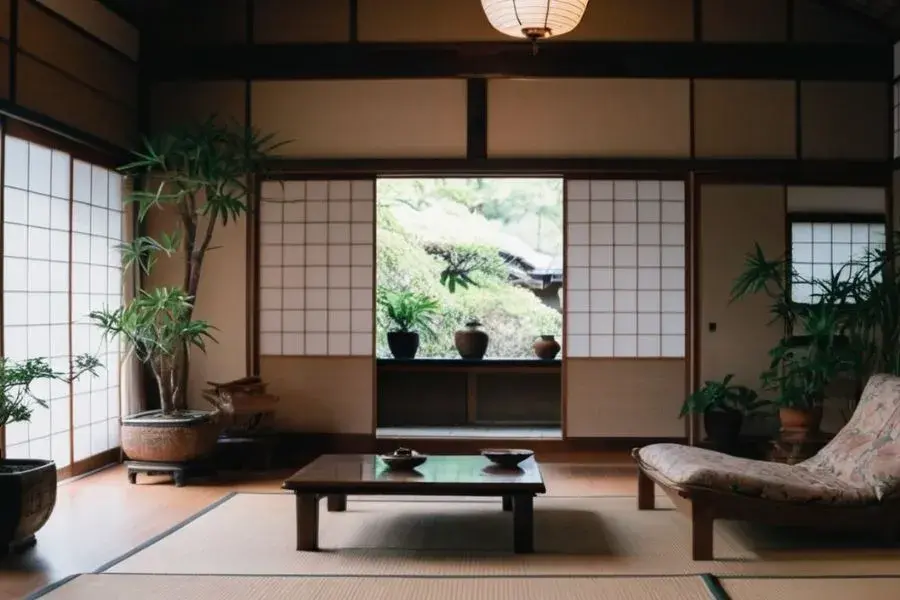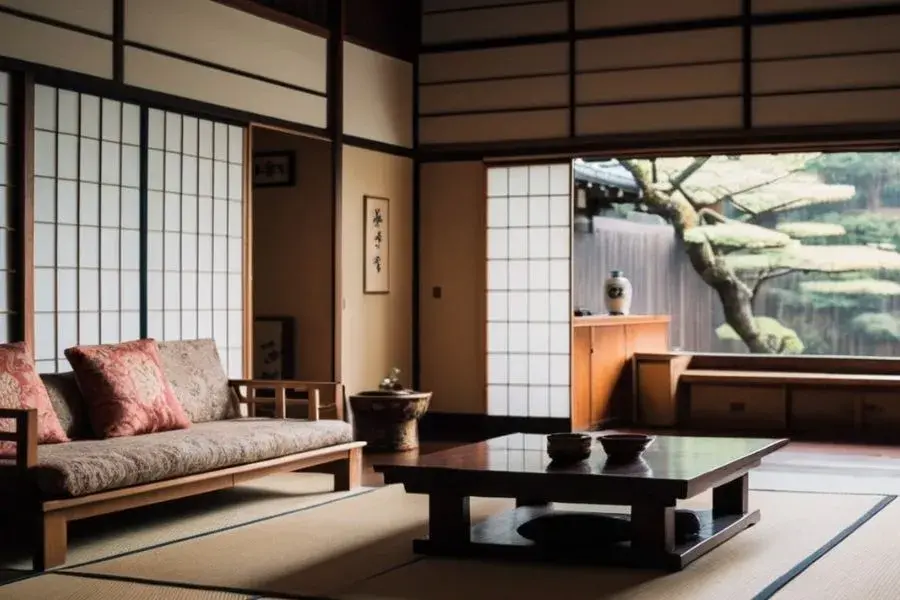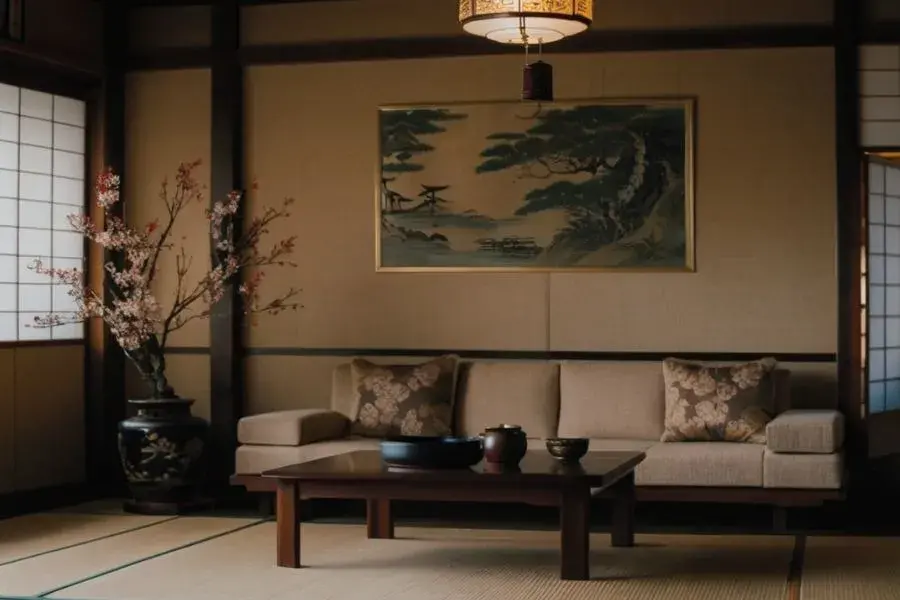Step into the realm of tranquility and timeless elegance as we explore the enchanting world of Japanese living room design. In recent years, the allure of these spaces has transcended cultural boundaries, captivating individuals worldwide with its minimalistic charm and deep-rooted symbolism. Japanese living rooms are not merely spaces; they are sanctuaries of serenity, where simplicity meets sophistication. This journey will unravel the intricacies of creating a harmonious haven within your home, where each element, carefully selected, contributes to a serene atmosphere. From the grace of minimalistic furniture to the artistry of Ikebana, embark with us on a quest to infuse your living space with the Zen essence of Japanese design.
Table of Contents
Key Elements of Japanese Living Room
Unlocking the secrets and techniques of the Japanese living room layout exhibits a meticulous choice of elements that remodel an area right into a sanctuary of tranquility.
Minimalistic Furniture
Central to Japanese living rooms is the philosophy of simplicity. Minimalistic furniture, characterized by the aid of using easy strains and uncluttered designs, fosters an surroundings of calm. Each piece serves a purpose, contributing to a purposeful but aesthetically pleasing environment. From low-slung sofas to ground cushions, each element is chosen with intention, permitting the room to respire and energy to waft freely.
Tatami Flooring
Beneath your toes lies the coronary heart of the Japanese residing room tradition: tatami flooring. Crafted from herbal substances like rice straw and rush, tatami affords a soft, resilient surface. Beyond its practicality, it symbolizes a connection to the earth, grounding the population in a mindful, present state.
Shoji Screens
Elegance takes shape inside the sensitive grace of Shoji screens. These sliding doors, crafted with washi paper and wooden lattice, provide a flexible technique for area division. Beyond their practicality, Shoji screens infuse the room with a diffused play of mild and shadow, growing a dance that resonates with the standards of concord.
Ikebana (Flower Arrangements)
More than mere decor, Ikebana, the artwork of flower arrangement, is a residing expression of concord and balance. By bringing nature indoors, Ikebana no longer best provides a hint of splendor but additionally cultivates mindfulness. The arrangement of plant life will become a poetic communication with the converting seasons, inviting a sense of temporal continuity into the room.
Incorporating those key elements, a Japanese living room will become a canvas wherein every desire contributes to a symphony of simplicity and purpose, fostering an environment that transcends the normal and embraces the extraordinary.

Color Palette and Aesthetics
The color palette in a Japanese living room serves as a brushstroke inside the canvas of tranquility, cautiously chosen to rouse a sense of concord and connection to nature.
Earthy Tones
Step right into a Japanese living room, and you are greeted by a palette stimulated by the herbal world. Earthy tones dominate, mirroring the colors of the landscape. Muted greens reminiscent of bamboo, heat browns such as timber textures, and tender whites reminiscent of cherry blossoms create a relaxing ambiance. These colors no longer simply please the attention but additionally foster a sense of connection to the serene landscapes that encourage Japanese design.
Use of Natural Materials
In the pursuit of concord, Japanese living rooms embody the authenticity of materials. Natural materials, which include timber, bamboo, and paper, aren’t the simplest decided on for aesthetic attraction but additionally for tactile warmth. The textures of those materials, from the smoothness of timber to the gentle rustle of paper, upload layers of sensory richness to the space.
Wabi-Sabi Philosophy
At the coronary heart of the color palette is the philosophy of Wabi-Sabi, celebrating imperfection and transience. Embracing the splendor observed inside the growing older process, Wabi-Sabi encourages a love for the imperfect and the popularity of the transient nature of life. This philosophy is contemplated through the intentional use of muted colors and herbal finishes, growing an environment that speaks of authenticity and the passage of time.
As every color and fabric is cautiously decided on, a Japanese living room will become a haven in which the subtleties of nature are introduced indoors. The color palette isn’t always simply a visible choice; it is an aware curation that resonates with the essence of simplicity and the splendor observed in life’s imperfections.
Furniture and Arrangement
In the rhythmic dance of Japanese living room design, the fixtures and their arrangement choreograph a symphony of simplicity, functionality, and aesthetic appeal.
Low Seating Options
Picture an area wherein the conventional is eschewed for the extraordinary – that is the essence of low-seating alternatives in Japanese living rooms. From ground cushions to the long-lasting futon, those seating choices braveness a grounded connection to the area. They now no longer best redefine the conventional seating arrangement however additionally domesticate an environment of informality, relaxation, and unhurried conversation.
Multifunctional Furniture
In the spirit of mindful living, Japanese living rooms embrace the concept of multifunctional furniture. Each piece is chosen now no longer only for its shape but additionally for its utility. Tables that remodel into garage devices, sofas that double as beds, and minimalist shelving devices seamlessly blend shape and function. This intentional selection ensures that each piece contributes to the room’s cause without compromising its visible appeal.
Open Spaces
The arrangement of furniture in a Japanese living room is similar to a cautiously composed haiku – concise, useful, and brimming with meaning. The emphasis is on growing open spaces, permitting the room to respire and energy to go with the drift freely. This planned arrangement no longer best contributes to the minimalist aesthetic however additionally fosters a sense of tranquility and calm. The absence of litter turns into a planned choice, inviting a conscious and intentional manner of dwelling.
As each piece of furniture finds its place in the room, a Japanese living space becomes a haven of purposeful design. It’s a dance of form and function, where every item serves a role in creating an environment that goes beyond the tangible and taps into the intangible essence of tranquility.

Read also: Tips to Make a Home Look Expensive On a Budget
Incorporating Nature Indoors
In the poetic tapestry of Japanese living room design, the incorporation of a natural interior isn’t an insignificant ornamental choice; it’s a deliberate act that connects inhabitants to the profound beauty of the natural world.
Indoor Plants
The presence of indoor flora transforms a Japanese living room right into a residing, respiration sanctuary. Greenery isn’t always simply a classy choice; it is a nod to the Japanese reverence for nature. From sensitive bonsai timber to resilient bamboo, those flora now no longer handiest purify the air but additionally create a visible connection to the outdoors. Each leaf turns into a brushstroke, including vibrancy and lifestyles in the room.
Nature-Inspired Decor
Beyond residing elements, Japanese living rooms often have characteristics of nature-stimulated decor. Wall artwork depicting serene landscapes, water functions reminiscent of babbling brooks, and even elements like pebbles or driftwood contribute to an immersive experience. This info isn’t simply ornaments; they may be portals that deliver the essence of nature into the coronary heart of the home, fostering a sense of calm and harmony.
Engaging the Five Senses
Japanese layout is going past the visual; it engages all of the senses. In a living room designed with Japanese aesthetics, the sounds of trickling water, the perfume of herbal materials, and the tactile experience of textured surfaces come together. Engaging the 5 senses transforms the residing area right into a multisensory journey, developing an environment in which each moment is a possibility for an aware connection.
As the herbal international seamlessly integrates into the living room, a Japanese-stimulated area turns into a party of the splendor that surrounds us. It’s a reminder that our connection to nature isn’t always separate; it is a critical part of our everyday lives, influencing no longer how our houses appear but also how they sense and resonate with the energy of the sector outside.
Lighting in Japanese Living Rooms
In the artful dance of Japanese living room design, lighting takes center stage as a conductor of ambiance, emphasizing the delicate balance between illumination and shadow.
Paper Lanterns
The gentle glow of paper lanterns casts a gentle luminosity, developing tranquil surroundings precise to Japanese living rooms. Crafted from sensitive washi paper and often presenting difficult designs, those lanterns diffuse mild in a manner that mimics the herbal filtering of daylight via leaves. The result isn’t always simply illumination; it is a poetic interaction of mild and shadow, infusing the room with a warm temperature that transcends the basic terms visual.
Ambient Lighting
Beyond the enduring paper lanterns, Japanese living rooms embody the idea of ambient lights. Carefully placed to keep away from harsh contrasts, ambient mild sources, along with low-wattage bulbs and recessed lights, contribute to a universal gentle illumination. The purpose is to create an environment in which mild is a diffused companion, guiding without overwhelming, and in which the transition between day and night time is a seamless, soothing experience.
Shining a Light on Zen
In the pursuit of making Zen surroundings, Japanese living rooms make use of lights as a device for mindfulness. The play of mild turns into a meditation in itself, with cautiously crafted shadows and gentle illumination contributing to the room’s universal serenity. The light layout isn’t always simply functional; it is a planned act that invitations moments of mirrored image and introspection.
As the day transitions into the evening, the lights in a Japanese-inspired living room transform, developing an ever-converting tableau of illumination. It’s a testament to the knowledge that mild isn’t always simply a realistic consideration; it is an important element that shapes the emotional panorama of the space, guiding the population right into a kingdom of tranquility and balance.

Read also: Brown-Themed Living Room Ideas and Tips
Cultural Influences
In the soulful choreography of Japanese living room design, cultural influences weave a tapestry that narrates tales of tradition, elegance, and a profound appreciation for artistry.
Fusuma Doors
At the coronary heart of Japanese architectural subculture lies the Fusuma door, an embodiment of versatility and grace. These sliding doorways, often embellished with superb artwork, offer a canvas for expression inside the living space. Beyond their practicality, Fusuma doorways contribute to the fluidity of the room, permitting the population to evolve and redefine their living areas with a hint of cultural elegance.
Traditional Art
Japanese living rooms often function as a gallery for a large array of conventional artwork. From ukiyo-e woodblock prints to sensitive porcelain, every piece tells a tale of Japan’s wealthy creative heritage. The planned inclusion of such artwork isn’t always simply decorative; it is a nod to a cultural legacy that values craftsmanship, aesthetics, and a deep connection to the roots of Japanese identity.
Calligraphy and Its Impact
The strokes of a broom turn out to be a shape of silent poetry in Japanese living rooms embellished with calligraphy. These cautiously crafted characters, often conveying profound philosophical meanings, upload a layer of highbrow intensity to the gap. Beyond aesthetics, calligraphy is a testament to the significance of mindfulness and intentionality in each issue of life, as conveyed via the artistry of the written word.
Harmonizing Tradition and Modernity
The integration of cultural influences in Japanese living rooms extends past mere artifacts; it is a sensitive dance between subculture and modernity. The room will become a level wherein centuries-vintage practices and present-day layout harmonize. It’s now no longer a conflict but an unbroken blend, wherein the echoes of the beyond resonate in concord with the heartbeat of the present.
In essence, cultural influences in Japanese living rooms remodel the gap right into a dwelling testament to Japan’s wealthy heritage. It’s a party of the continuity of traditions, an homage to the profound artistry embedded in normal life, and a reminder that the splendor of the beyond can seamlessly coexist with the improvements of the present.
Creating a Zen Atmosphere
In the tranquil sanctuary of the Japanese living room layout, the hunt for a Zen ecosystem transcends aesthetics; it is an aware adventure that unfolds through planned selections and a profound connection to the essence of serenity.
Meditation Corners
Elevating the living room from an insignificant area to a haven of contemplation, meditation corners carve out intimate regions for mindfulness. Soft cushions or tatami mats end up structures for reflection, encouraging moments of stillness amidst the everyday bustle. The layout is intentional, fostering an environment in which the population can retreat right into a realm of calm, locating solace inside the simplicity of the present moment.
Importance of Empty Spaces
In the philosophy of Japanese living room layout, empty areas aren’t voids to be stuffed but canvases that invite contemplation. The significance of empty areas is profound; they offer room for the thoughts to breathe, fostering a sense of openness and tranquility. Walls aren’t cluttered with pointless decor, and furnishings are not crowded – every element is purposefully placed, making an allowance for a dance of vacancy that resonates with the standards of Zen.
Calming Soundscape
Silence in a Japanese living room isn’t always an absence but a presence, a canvas for the diffused symphony of a chilled soundscape. Whether it is the gentle glide of water from an ornamental fountain, the rustling of leaves inside the wind, or the remote sound of a conventional Japanese instrument, the auditory panorama is curated to awaken a sense of peace. Every sound turns into a brushstroke, portraying the room with a serene melody.
As the population navigates the area, the Zen atmosphere isn’t always a static kingdom but a dynamic experience. It’s an adventure that unfolds with each breath, inviting a sense of calm into the very material of everyday life. In growing a Zen ecosystem, a Japanese-inspired living room turns into no longer only a bodily area but an aware refuge, in which the hunt for tranquility turns into an everyday ritual.

Tips for Small Spaces
In the intricate dance of Japanese living room design, the challenge of small spaces transforms into an opportunity for creative ingenuity. Here are practical tips to maximize every inch, creating an oasis of tranquility even in the coziest corners.
Maximizing Vertical Space
When the ground area is a premium, the gaze turns upward. Embrace the artwork of maximizing vertical area with tall bookshelves, a wall-hooked-up garage, and striking decor. This attracts the attention upward, growing a phantasm of peak and openness. By utilizing vertical surfaces, you no longer best optimize the garage however additionally create a visually expansive sense inside the room.
Dual-Purpose Furniture
In the world of small spaces, each piece of Furniture has to be a multitasker. Opt for dual-purpose furniture that serves each shape and function. Consider a coffee table with hidden storage, a sofa that transforms into a bed, or ottomans that double as storage units. These flexible portions streamline the room, imparting realistic answers without compromising on style.
Illusion of Space
The artwork of making an illusion of the area lies in strategic layout choices. Opt for mild-coloured fixtures and partitions to mirror herbal mild, making the room sense brighter and extra open. Mirrors are a useful asset; they no longer upload a hint of beauty but additionally make the notion of area via way of means of reflecting each mild and the room’s decor.
Minimalistic Approach
In small spaces, much less is often extra. Embrace a minimalistic technique in decor and furniture. Select some statement portions that align with Japanese aesthetics and serve a cause. Avoid clutter, permitting the simplicity of the layout to shine. This intentional minimalism now no longer best maximizes area however additionally contributes to a serene and uncluttered atmosphere.
Engaging Tatami Mats
Tatami mats, past being a floor choice, can function as flexible elements in a small living room. They may be rolled up and saved when no longer in use, releasing up-ground areas for different sports. When needed, they offer a cushy seating location or a delegated area for sports like meditation or yoga, contributing to a bendy and adaptable environment.
As small spaces transform into cozy sanctuaries, these tips embrace the essence of Japanese living room design-prioritizing intentionality, functionality, and a commitment to creating spaces that feel expansive, even within limited square footage.
Maintenance and Cleaning
In the Zen-inspired haven of Japanese living room design, the principles of simplicity extend seamlessly into the realm of maintenance and cleaning. Here’s a guide to effortlessly uphold the serenity of your space.
Simplicity in Cleaning
Japanese living rooms have a good time with the splendor of simplicity in each aspect, which includes cleansing. Opt for an easy cleansing recurring that aligns with the minimalist ethos. Keep surfaces clean of needless items, making them less complicated to wipe down and maintain. Embracing a much less-is-extra philosophy extends to cleansing merchandise as well—pick natural, eco-friendly alternatives that echo the commitment to a harmonious reference to the environment.
Mindful Arrangement
The arrangement of furniture and decor isn’t always pretty much aesthetics; it performs an essential position inside the ease of maintenance. Adopt a conscious arrangement that lets in for efficient cleansing. Avoid overcrowding and pick fixtures with smooth traces that are clean to navigate around. This intentional format no longer most effectively contributes to the general visible enchantment however additionally simplifies the cleansing procedure.
Longevity of Design
Japanese living room layout often includes elements that resist the check of time. Select furniture and decor with an emphasis on sturdiness and longevity. Materials like stable timber and first-rate fabric now no longer the most effective contributions to the authenticity of the layout however additionally require much less frequent replacement, decreasing the environmental effect and simplifying the long-time period maintenance of the area.
Considerate Use of Decor
In the spirit of mindful living, pick decor that isn’t most effective and aesthetically desirable but additionally clean to maintain. Opt for portions that are dust-resistant and easy to smooth. This ensures that the splendor of the room stays on hand without the burden of extensive upkeep. Considerate use of decor contributes to an environment in which cleansing turns into a conscious and conceivable task.
Regular Decluttering
A clutter-free living room no longer most effectively aligns with Japanese aesthetics however additionally simplifies the cleansing procedure. Regular decluttering sessions prevent the accumulation of unnecessary items, making it easier to reach every nook and cranny during cleaning. This exercise no longer most effectively continues the visible enchantment of the room however additionally fosters a sense of mental readability and order.
As you embark on the adventure of maintaining and cleansing your Japanese-inspired living room, do not forget that the procedure isn’t pretty much cleanliness; it is a possibility to engage with your area mindfully. Each wipe, every rearrangement, turns into a shape of meditation, aligning with the standards of Zen that commemorate simplicity, intentionality, and the splendor discovered inside the everyday moments of each day’s life.
Cost-Effective Japanese Living Room Ideas
Embarking on an adventure to infuse Japanese aesthetics into your residing area does not have to interrupt the bank. Here’s a manual to attaining a serene and elegant Japanese-stimulated residing room on a budget.
Embrace Minimalism
At the heart of the Japanese design is the celebration of simplicity. Embrace minimalism with the aid of decluttering and paring down unnecessary objects. This now no longer fees not anything however saves cash with the aid of fending off the acquisition of superfluous decorations. Let the splendor of essential elements take center stage, developing an area that feels open, calm, and purposeful.
DIY Shoji Screens
Capture the beauty of conventional Japanese Shoji screens without the hefty price tag with the aid of embracing a DIY approach. Create your model with the use of less costly substances like wooden frames and rice paper. This no longer provides a hint of authenticity in your living room however additionally permits for a personalized, homemade element that resonates with the Japanese appreciation for craftsmanship.
Thrift Store Finds
Embark on a treasure hunt at thrift shops or second-hand shops. Look for low-slung furniture, ground cushions, and herbal substances like bamboo or wooden pieces. You may come across hidden gemstones that align flawlessly with the Japanese aesthetic. Thrift Keep is no longer the simplest shop cash however additionally makes contributions to sustainable living with the aid of giving pre-loved objects a second life in your living room.
Nature-Inspired DIY Decor
Bring the outside in with the aid of incorporating nature-inspired DIY decor. Collect branches or driftwood to create a unique wall artwork piece. Paint stones in calming shades or repurpose glass jars into minimalist vases for showing easy floral arrangements. This no longer provides a hint of nature in your area however additionally permits innovative expression without breaking the budget.
Tatami Mat Alternatives
While authentic tatami mats may be pricey, less costly options like bamboo or woven grass mats can offer a comparable aesthetic at a fragment of the fee. These mats may be used strategically to outline seating regions or to create a chosen area for meditation. They no longer upload texture to the room however additionally make contributions to the general Japanese-inspired ambiance.
DIY Zen Garden Corner
Transform a neglected corner right into a serene DIY Zen garden. Use inexpensive pebbles, sand, and some cautiously located rocks to create a miniature oasis. This small addition can carry a sense of tranquility to the room, offering a visual escape that is both cost-effective and spiritually enriching.
Soft Lighting with DIY Paper Lanterns
Create soft, ambient lights reminiscent of conventional Japanese paper lanterns with DIY paper lanterns. Utilize less costly substances like paper or lightweight material to craft those fashionable additions. Their gentle glow can rework the atmosphere of your residing room, offering an inexpensive but impactful nod to the Japanese design.
By incorporating those powerful ideas, you may rework your living room right into a Japanese-inspired haven without stretching your budget. Remember, it is now no longer approximately the fee of personal objects but the considerate curation and arrangement that seize the essence of Japanese aesthetics.

FAQs
1. Why is simplicity important in Japanese living room design?
Simplicity is a core tenet of Japanese aesthetics, promoting a sense of tranquility and harmony. The intentional omission of clutter allows for a more mindful and serene living space.
2. How can I achieve a Japanese-inspired living room on a budget?
Opt for budget-friendly options like thrift store finds, DIY projects, and minimalist decor. These choices align with Japanese design principles while keeping costs down.
3. What are some traditional elements of Japanese living rooms?
Traditional elements include tatami flooring for a connection to nature, Shoji screens for space division, Ikebana for artistic floral arrangements, and Fusuma doors for versatility and elegance.
4. How does lighting contribute to a Zen atmosphere in Japanese design?
Soft, ambient lighting, inspired by traditional paper lanterns, plays a crucial role. It creates a delicate balance between illumination and shadow, fostering a tranquil and meditative environment.
5. Why is nature incorporation essential in Japanese living rooms?
Nature integration brings an inherent sense of tranquility. Indoor plants, nature-inspired decor, and a calming soundscape contribute to a harmonious living space, reflecting the Japanese reverence for the natural world.
Conclusion
In the artful tapestry of Japanese living room design, simplicity reigns supreme. From minimalist arrangements to DIY touches, each element serves a purpose, fostering an environment of tranquility and purposeful living. Our cost-effective ideas remind us that real splendor lies in considerate curation, sustainability, and locating pleasure in simplicity.
As you embark on this transformative journey, don’t forget that Japanese design isn’t always pretty much aesthetics; it’s a mindful engagement with your space. May your living room be a visual sanctuary, reflecting your values and inspiring a mindful approach to daily living. In the dance of simplicity and elegance, may your space embody the timeless beauty inherent in Japanese design.